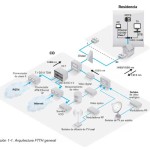HD video are required to watch by subsribers, the hair like fiber core able to delivery enomous data from central office to users. fiber optic right now is the remarkable technology for data transmission. Nowadays, its quite economical to use fiber to carry informaiton to the premises, to increase the international communication. This essay is for elaborate the challenge of FTTH (Fiber to the Home)
Compared with FTTB (fiber to the building), FTTC (fiber to the curb), FTTH (or FTTP) is relatively more complicated because it is much more costly and difficult, a fiber link was lead from the central office to the local distribution hub, from there, runs multiple drops after splitting (we call it “Last Drop” in FTTx industry) from local exchange to multiple homes via street, buildings, etc. This section is the most challenge part during installation.

The transmission medium that currently lead from the cabinets to the homes are typically twisted pairs or coaxial cable (in mature markets especially in U.S or western country). Most Service Providers in these markets have chosen to take the installing fiber to the curb distribution hub and using copper/coaxial to the premise because performance is good enough in the early stages, and because it still makes sense to maximise the user value of the existing (and already paid for) infrastructure. However, faster Internet speed demand is growing than current copper/coaxial could not meet, thus the pressure is growing on operators to expanding FTTH network.
Based on some statistics, FTTH projectpenetration rates already increased about 30%, from a low of 20% in the first few years of deployment to a high of 50% when deployments are complete. The last thing an operator wants to do after installing a new fiber network is to disappoint its customer base with delays. But nor does it want to invest in expensive cable and ancillary electronic equipment like ONT/ONU and wireless routers if there is not sufficient demand. It is vital that operators do their due diligence and get these calculations right prior to deploying a network.
Fiber optic cable is a truly remarkable technology. With a single strand of fiber glass no thicker than a human hair, it is possible to deliver crystal clear voice communications and virtually unlimited bandwidth direct to a premise. 01 But the decision to deploy fiber is only the first step. When it comes to actually implementing an FTTH network, there are several factors that need to be taken into account. Choices have to be made based on landscape topography – there is a world of difference between deploying FTTH in a rural and urban landscape. Regulatory issues need to be addressed; they cannot simply be sidestepped. Technical factors must also be carefully weighed – techniques like cable blowing and pulling only work in certain situations. Then there is the matter of cost. Depending upon the solution chosen, operators may need to hire specialist staff and equipment at extra expense.
It is also critical that customers are not inconvenienced at any point during an FTTH implementation. No customer wants their property to be at the centre of a major civil engineering project. As we shall see later in the paper, this factor alone can dictate which technical solution is chosen for the last drop.
Lastly, network operators need to consider whether they want their solution to be future proof. Some cable can be ripped and replaced. But there are other options – such as direct unducted cable – which once installed cannot easily be removed.
The purpose of this eBook is to outline the choices available to network operators seeking to solve the last drop challenge. Over the course of the next few pages, we will investigate the advantages and disadvantages of using buried or aerial cable. We will then drill down further and explore the pros and cons of using cable, cable in duct, blown, pushable and pullable cable. Our intention is to give you a complete and impartial overview of the technical landscape so you can make the right choices for your business.